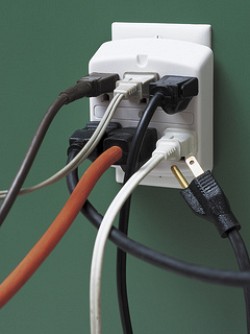Surprising Energy Vampires and How to Subdue Them
 Is your home playing host to evil energy vampires? Beware! Also known as a "phantom," an energy vampire is a nick-name for any electrical device or appliance that consumes power even when it is on stand-by mode … or turned off completely! As long as it is connected to the power source, it will continue to slowly suck electricity. This wastes power and your hard-earned cash.
Is your home playing host to evil energy vampires? Beware! Also known as a "phantom," an energy vampire is a nick-name for any electrical device or appliance that consumes power even when it is on stand-by mode … or turned off completely! As long as it is connected to the power source, it will continue to slowly suck electricity. This wastes power and your hard-earned cash.
Why does saving electricity matter?
Conserving electricity is vitally important for the health of our environment. Electricity generation was responsible for 32 percent of all US greenhouse gas emissions in 2012, more than any other source. Greenhouse gases act to trap heat and contribute to global warming. Some 70 percent of the USA's electric power is currently produced by burning non-renewable resources -- namely, fossil fuels, most notably natural gas and coal.
Besides its contribution to the health of our planet, on a more prosaic level reducing your electricity consumption will save you money on utility bills.
Do energy vampires really consume a significant amount of electricity?
The average American household makes use of many more electrical appliances such as computers, microwaves, and dishwashers, as well as devices requiring chargers, than it did 50 years ago. This drastically increased number of devices, even though each one may consume a relatively small amount of energy while at rest, adds up to a significantly greater consumption.
The government's Lawrence Berkeley Laboratory has performed detailed research on the amount of standby power used in the home. Their report includes a table showing some of the most common home energy vampires and how much energy each one consumes, in both "on" and "off" mode. Amounts range from an average of less than 1 watt for an air conditioner to the biggest culprit, a TV set-top box, which can gobble an amazing 43 watts -- and that's when it's switched off! Multiply those figures by 9 to get the kilowatt hours each device uses annually, at a cost of about $1.00 per kWh, and you'll see what a significant quantity of electricity is being wasted.
As an informative exercise, purchase or borrow a wattmeter to measure electricity usage by the appliances in your own home. Alternatively, try an online electricity-usage monitoring tool.
What can you do about it?
Start with the oft-repeated suggestions. Plug appliances, and especially energy-hungry chargers for laptops and mobile devices, into power strips and turn off the entire strip when you will not be using it. Program your computers to switch over to "sleep" mode whenever they haven't been used for fifteen minutes. Douse light fixtures and adjust your heating or air conditioning according to when family members are at home and active; use timers and programmable thermostats to help you.
Even more energy-saving ideas
Beyond the basics, keep your eyes open for inventive ways to put the energy vampires to rest. Here are a few to get you started:
Keeping your appliances clean and in excellent operating condition is a must for electric-efficient use. Your hardworking HVAC deserves particular attention; clean the filters and be sure to schedule regular maintenance for the system.
Reset your refrigerator in winter, when cooler ambient air may cause its temperature to drop unnecessarily low. Thirty-eight to 40 degrees F is ideal for both food safety and efficient operation.
Continue to use the low-electricity cold water setting on your washer if you are already doing so. Otherwise, winter is the perfect time to begin. Clothes are likely to be only lightly soiled in this season, when few people sit on the grass or work in the garden.
Take care of sources of heat loss. Make sure the damper is closed when you're not using your fireplace. Dust your light bulbs to increase their efficiency. And get that leaky hot water faucet fixed. It's wasting water and power.
Laura Firszt writes for networx.com.
Looking for a Pro? Call us (866) 441-6648

Heating & cooling Average Costs
HVAC Contractors Experiences

I Built A Concrete Retaining Wall As A Defense Against El Nino

Oak Tree Planting Looks Great In Our New Home’s Spacious Yard



